The Savoy Ballroom, more than just the home of Happy Feet
“If you loved music and you loved dancing, the Savoy was the place to go.” (Frankie Manning in his autobiography)
If you consider yourself a Lindy Hopper, then you have probably heard of the great Savoy Ballroom, in Harlem, NY. It was one of the most important and influential places for the birth and development of Lindy Hop in the late 1920s and well into the 1930s and 40s. Are you ready to learn the most important facts about “the world’s finest ballroom” and why it was so important to Lindy Hop?
“Owned by Moe Gale, a Jewish man, and managed by Charles Buchanan, a black man, the Savoy Ballroom opened its doors on March 12, 1926 right in the middle of Harlem, between 140th and 141st Streets on Lenox Avenue. The vision of the two young men created one of the first racially integrated public places in the country, which proved to be a wise business decision as well, attracting a wide range of clientele.” (Savoy Plaque)
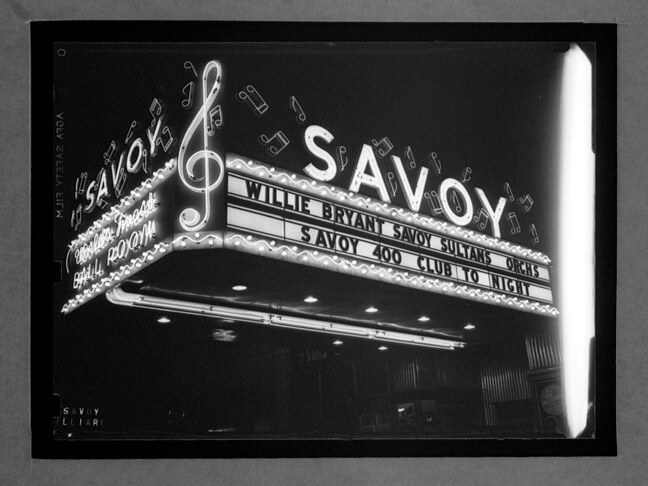
The large ballroom would have between 4,000 and 5,000 people walk in at any night, and would open for the public 5 nights of the week, leaving the extra two nights for private events and parties. The admission varied between $0.30 to $0.85, depending on the time you arrived. The earlier, the cheaper. “There were approx. 90 permanent employees at the Savoy, which included musicians, waiters, cashiers, floor attendants, porters and administrative assistants.” (Welcome to Harlem)
“The club was a center for Jazz music and dance, where some of the most important individuals performed what was called “Swing Dance.” In those days, you couldn’t take a class in Swing Dance. Night Clubbers went to the jazz clubs to learn this cutting-edge music and dance.” (Ohio State University)
The ballroom hosted around 700,000 people every year, and even though the manager Charles Buchanan was very meticulous about the maintenance and cleaning of the floor after each night of dancing, the floor still needed to be replaced every three years to maintain its great standard for dancers. There was no smoking allowed on the floor, and whoever disrespected that rule was ejected after one warning. Also, because the floor was at the second story, they needed to have periodical checkups to ensure it wouldn’t collapse and send the dancers crashing through to the floor below.
“The Savoy was appropriately nicknamed, “The home of happy feet,” and it was also known among the regular patrons as “the Track” for the elongated shape of the dance floor.” (Savoy Plaque)
You can see what the dance floor looked like in the picture below.

Picture taken from: https://swungover.wordpress.com/2016/01/07/the-savoy-clarified/
Unfortunately, today there is no trace of the Savoy in its location. In 1958 it had to be shut down to give way to a much needed housing complex in the neighborhood. So, we can’t help but wonder what the ballroom must have looked like…
We tend to think about the past as being in black and white since this is the reference we have from pictures. The Savoy, however, was filled with bright colors, luxuriously carpeted lounges, and mirrored walls.
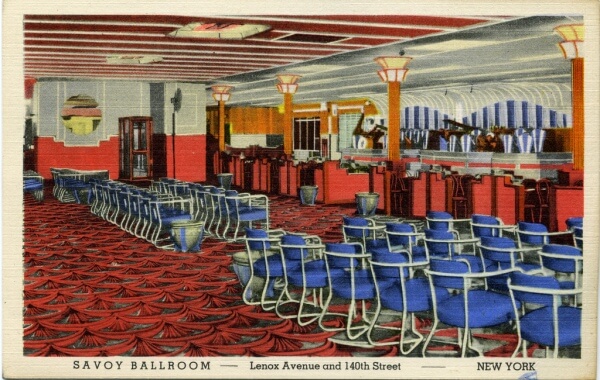
Picture taken from https://swungover.wordpress.com/2016/01/07/the-savoy-clarified/
“Upon entering the Savoy Ballroom, you descended one floor to check your hat and coat at one of the several ornate counters staffed by a small army of attendants. Then you climbed two mirrored flights of marble steps until you found yourself in a teeming crowd in the middle of a block-long dance floor. Directly opposite, a raised double bandstand gleamed with instruments, and one of two bands was up there in full swing.” (Stearns and Stearns, Jazz Dance)
Here’s how Leon James described his first impression of the Savoy:
“My first impression was that I had stepped into a different world. I had been to other ballrooms, but this was different-much bigger, more glamor, more class…” (quoted in Stearns & Stearns “Jazz Dance”)
In his autobiography, Frankie Manning also shares the impact he felt the anticipated first time he entered the Savoy ballroom:
“As I was climbing the steps that led to the ballroom, I could hear this swinging music coming down the stairwell, and it started seeping into my body. I got to the top step, went through the double doors, and stopped for a moment with my back to the bandstand, taking it all in. When I turned around and faced the room… well, I just stood there with my mouth open. The whole floor was full of people—and they were dancing! The band was pounding! The guys up there were wailing! The music was rompin’ and stompin’. Everybody was movin’ and groovin’.”
If you want to watch a glimpse of Frankie social dancing at the Savoy, make sure to watch this clip from Ken Burn’s documentary:
“The Savoy was pink on the inside and had a good size foyer as you entered the building, was very well-ventilated (Air-conditioning not yet invented), and had modern furniture of the times and mirrored walls… Originally, the bar only served soft drinks, beer and wine, no hard liquor was served in the early years at the Savoy. The soda fountain bar served up ice cream drinks and dishes such as Banana Splits, Sundaes and Floats.” (Streetswing)
Thanks to research made by Mike Thibault and shared by Bobby White, we have the original floor plan of the Savoy where we can see where each spot was located and how the room was organized. It’s possible to see that the dance floor, which we think of as huge, occupied less than 50% of the space from the whole ballroom. This reminds us that the Savoy was just as much a Social Club as it was a Dance Club.
One very important spot to highlight that is not marked on the floor plan is what was called the “Cat’s Corner”, the place where all the best dancers would get together and jam! This corner was located on the northeast side of the ballroom, next to the main bandstand, and only the best dancers were allowed to be there. “There an invisible rope surrounded a dancing area that met the requirements of ritual, recreation and performance.” (Jacqui Malone, “Steppin’ on the Blues”). Dancers such as Al Minns, Leon James, Shorty Geroge, Big Bea, Norma Miller, Frankie Manning, and many others would go there to show off their moves to each other and to curious onlookers.
Of course, we associate this ballroom with Lindy Hop, but that wasn’t the only dance being done there.
“Dances that started or were made popular at the Savoy included the lindy hop, the flying charleston, the big apple, the stomp, the jitterbug jive, the snakehips, the rhumboogie, variations of the shimmy and the peabody, and new interpretations of the bunny hug and the turkey trott.” (Jacqui Malone, “Steppin’ on the Blues”)
Lindy Hop is said to have originated at the Savoy, so it comes as no surprise that the ballroom had the best Lindy Hoppers in the world. As high level of dancing was one of the main attractions on the dance floor each night, the manager Charles Buchanan would have make an effort to make sure they would be present each night doing their best moves. To make this possible, the best dancers were allowed to rehearse inside the ballroom during the day (for free) and had access to the Cat’s Corner. These fancy-pants dancers were commonly known as Whitey’s Lindy Hoppers, named after Hubert White (a.k.a. Whitey, an ex-boxer and bouncer at the Savoy) as the leader.
In Ken Burn’s documentary about Jazz, Norma Miller shares an early memory about the Savoy from before she ever entered the ballroom:
“The windows were wide open and so the music could come out and blast right into our living room. Every night we heard this marvelous music. In those days, in the summer, the fire escape was where you sat to be cooled, there was no air conditioning anywhere… Our fire escape faced the windows of the Savoy Ballroom. And you could see shadows when people danced past the windows. You could see figures dancing to that music. My sister and I would respond to what we saw in the windows of the Savoy and would get into the living room and dance to some of the best bands in the world.”
Norma sure was lucky to be able to dance to the best jazz bands in the world from her living room!
You can watch her talking about the Savoy in the video below:
Besides social dancing and performances, the ballroom also hosted weekly dance contests, which were very popular. “The contests were generally held on Wednesdays with prizes going to third place. First place was around $40 in the early days and a chance to perform a solo dance exhibition at the Savoy. The Harvest Moon Ball held its prelims for the Swing Division at the Savoy Ballroom” (Welcome to Harlem)
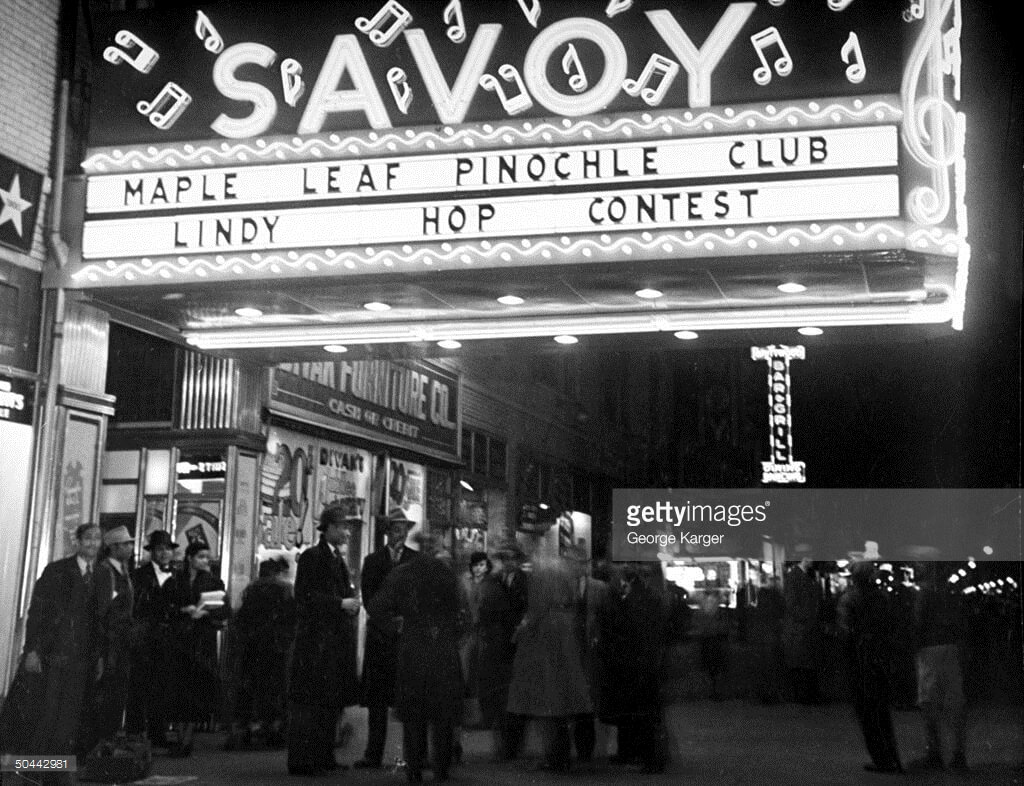
We tend to assume that the Savoy only played Jazz music all night every night. However, that was not the case. Besides the dance styles originated from Jazz music, there were also other styles of dancing that were done at the Savoy to different music, such as the Waltz or the Mambo. Nonetheless, the ballroom was most known for its great level of Swing music and dance. And not only was it the place where many of the Jazz dances were born and developed – such as the Lindy Hop – but it was also a place where jazz developed into swing music.
“One of the reasons for the early development of great big-band jazz at the Savoy was the presence of great dancers”. (Stearns & Stearns, “Jazz Dance”)
There is no doubt about how the Savoy Ballroom hosted the best swing bands in the whole country. Having two bandstands, there would always be two bands ready to take turns and play, making sure that the music never stopped. The Savoy patrons were considered the “hippest” dance audience in the world, so playing there was the ultimate test of a true dance band. There were the house bands, who played there regularly, and the guest bands, who were invited for special occasions.
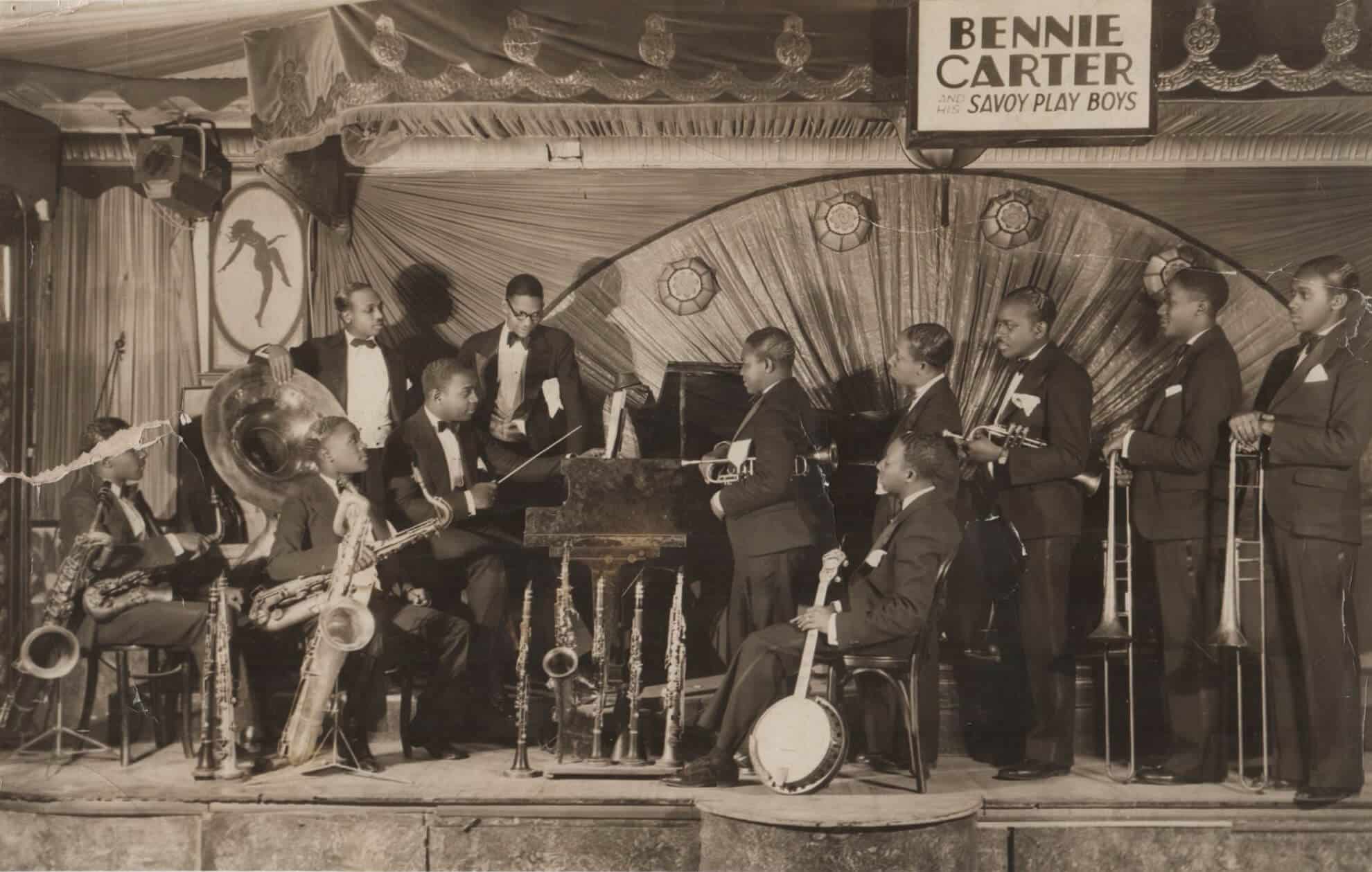
The house bands included Fess Williams, Erskin Hawkins, Al Cooper’s Savoy Sultans, and, the most famous one, Chick Webb.
Some of the other great musicians who played at the Savoy were Duke Ellington, Louis Armstrong, King Oliver, Ella Fitzgerald, Billie Holiday, Coleman Hawkins, Erskine Hawkins, Benny Carter, Earl Hines, Don Redman, Teddy Hill, Jimmie Lunceford, Andy Kirk, Dizzy Gillespie, Charlie Parker, Art Blakey, and Thelonious Monk. Believe me, the list could go on and on. Every great jazz musician from that time had played at the Savoy at least once.
It’s impossible to talk about the bands featured at the Savoy and not mention the famous Battle of the Bands. A special occasion, in which the house band of the Savoy – mainly Chick Webb’s band – would battle another great big band, such as Duke Ellington’s or Count Basie’s. The dancers would go wild on those nights and the ballroom would sometimes double its capacity because of all the people wanting to get it. The crowd would cheer for their favorite band who would walk out as the winner of the battle – most times it was the incomparable Chick Webb.
The most epic of those battles—mentioned in different sources—was the one between Chick Webb and Benny Goodman’s orchestra. “One of the most famous battles at the Savoy was the night the Benny Goodman Band faced Chick Webb and His Little Chicks. The Savoy was packed and many more people waited outside. For blocks, traffic was backed up in every direction – with approximately twenty-five thousand people trying to attend. Goodman pulled out all of his guns, but could not win the crowd. When Webb ended the session with a drum solo, the dancers exploded in a thunderous ovation.” (Jacqui Malone, “Steppin’ on the Blues”) Does part of you wish you could have been there to enjoy that great live music? Because I sure do!
While we weren’t there to see it, Frankie Manning and Norma Miller were! In this clip from Ken Burn’s documentary they share their memories of experiencing that battle live:
“The allowing of inter-racial dancing of Blacks and Whites was really frowned upon by both races at the time at other night spots, but not at the Savoy. The Savoy hardly had any problems with fights or troublemakers due to racial issues. People learnt to overlook their differences and respect the true meaning of the Savoy, its music and dance, and if not its strict bouncers would fix any problems fast.” (Welcome to Harlem)
Because it was owned by a Jewish man and run by a Black man, the Savoy was one of the first ballrooms to truly integrate Black and White audiences in the country. It is estimated that about 85% of the clientele was Black and 15% White, but those numbers could vary depending on the night. It is important to highlight that it was located in Harlem, which – even though it was mainly a Black neighborhood – was acceptable for white people to attend (just Take the A Train). The opposite, however, was extremely rare and faced many barriers. Black people were not allowed to attend ballrooms or other venues in the richer white neighborhoods, such as the Cotton Club.
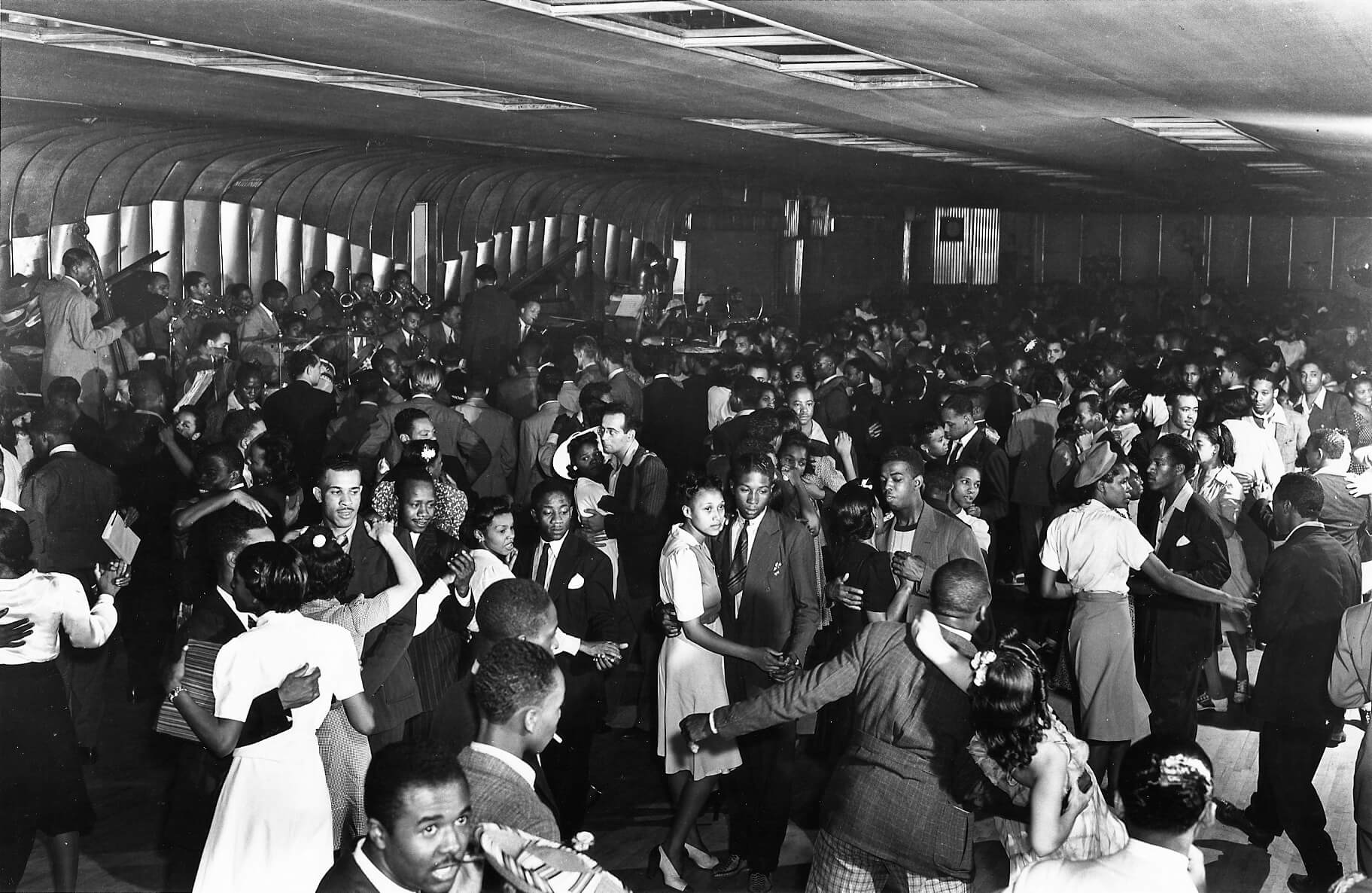
Other ballrooms, such as the Roseland, would have an integrated night, but they would put up a rope in the middle on the dance floor separating white and black dancers. The Savoy was the only place where it was perfectly normal and acceptable for interracial couples to dance together.
The Savoy was more than just a ballroom for dancers and music enthusiasts. It was the place of birth of Lindy Hop, Swing music, and many other great dance styles and artists from the Jazz Age.
“The Savoy was one of the great centers of culture in the United States, even though it was then thought of as simply a place of entertainment.” (Jacqui Malone, “Steppin’ on the Blues”)
“No institution had more to do with the development or the sophistication, the variety, the richness and the precision of jazz than institutions like the Savoy ballroom. But dance has always been central and I always want to see jazz connected to dance.” (Albert Murray, quoted in “Steppin’ on the Blues”)
Sadly, there came a time when it wasn’t possible to keep the doors to the Savoy open anymore. In the 1940s, drugs started to become a real problem throughout the country and in Harlem specifically. By the 1950s, the scene of the neighborhood had changed a lot and the Savoy and other big ballrooms were losing their clientele to smaller drinking clubs. They tried different strategies to keep their activities running, but people weren’t attending large ballrooms anymore as they were in the 1920s and 1930s. Eventually, the building had to close and be demolished to make place for a housing complex.
Today, if you visit the place where the Savoy used to be, you will find a commemorative plaque which was revealed on May 26 2002 by Frankie Manning and Norma Miller, celebrating the legacy of this great ballroom that achieved great success socially, musically, and in dance.
In remembering the Savoy Ballroom, learning its history and its importance, we are keeping a very essential part of African American culture and history alive.

“Apparently they were looking for a classy name and decided that the Savoy Hotel, in The Strand, London was the one to imitate. There’s no copyright on the name as the London Hotel’s name refers back to the Savoy Theatre that it was built next to, which in turn referred to the former Savoy Palace that stood on the same site until rebellious peasants burnt it down in the 14th century. Even that name was brought over to England by royal relatives of Henry III who had some kind of claim on the province of Savoy in Italy that was then an independent state! In Italy, Savoy became the name of the Italian royal family who, because of their collaboration with Mussolini’s fascist dictatorship in the 1930s, now live in exile. The Harlem Savoy came to stand for a totally different set of values!” (Welcome to Harlem)
“There were other Savoy’s, not all were like the famous Harlem Savoy, however only one was connected to the Harlem Savoy. Hubert “Whitey” White around 1945 opened his own Savoy Ballroom in Oswego, New York with the assistance of Savoy’s own Charles Buchanon. London, England had the Savoy Hotel in the 1920’s which featured many American bands and dancers and hosted a Radio Show each week. Chicago had a Savoy Ballroom which opened in November 1927, having Louis Armstrong and Carroll Dickinson play there. Barron Wilkins (Exclusive Club fame) opened the Little Savoy in Midtown, New York in the early 1900s. Boston, MA. had a Savoy in the 1940’s, Los Angeles had a nightclub and the Savoy Hotel, located on 601 West 6th. Street, and there was even a Savoy Ballroom in Bakersfield, California in the late 1940’s.” (Streetswing)
The Savoy Ballroom, Harlem NY, Welcome to Harlem (https://welcometoharlem.com/the-savoy-ballroom/)
The Savoy, Clarified, Swungover (https://swungover.wordpress.com/2016/01/07/the-savoy-clarified/)
The Savoy Ballroom, Streetswing (https://www.streetswing.com/histmain/z3savoy1.htm)
About the Savoy Ballroom, Savoy Plaque (http://www.savoyplaque.org/about_savoy.htm)
The Savoy Ballroom, Ohio State University (https://aaep1600.osu.edu/book/01_SavoyBallroom.php)
Jazz Dance, Marshall & Jean Stearns,1968
Steppin’ on the Blues, Jacqui Malone, 1996
Frankie Manning – Ambassador of Lindy Hop, Frankie Manning and Cynthia R. Mllman, 2007